FORD ESCAPE 2013 3.G Owners Manual
Manufacturer: FORD, Model Year: 2013, Model line: ESCAPE, Model: FORD ESCAPE 2013 3.GPages: 423, PDF Size: 4.59 MB
Page 181 of 423
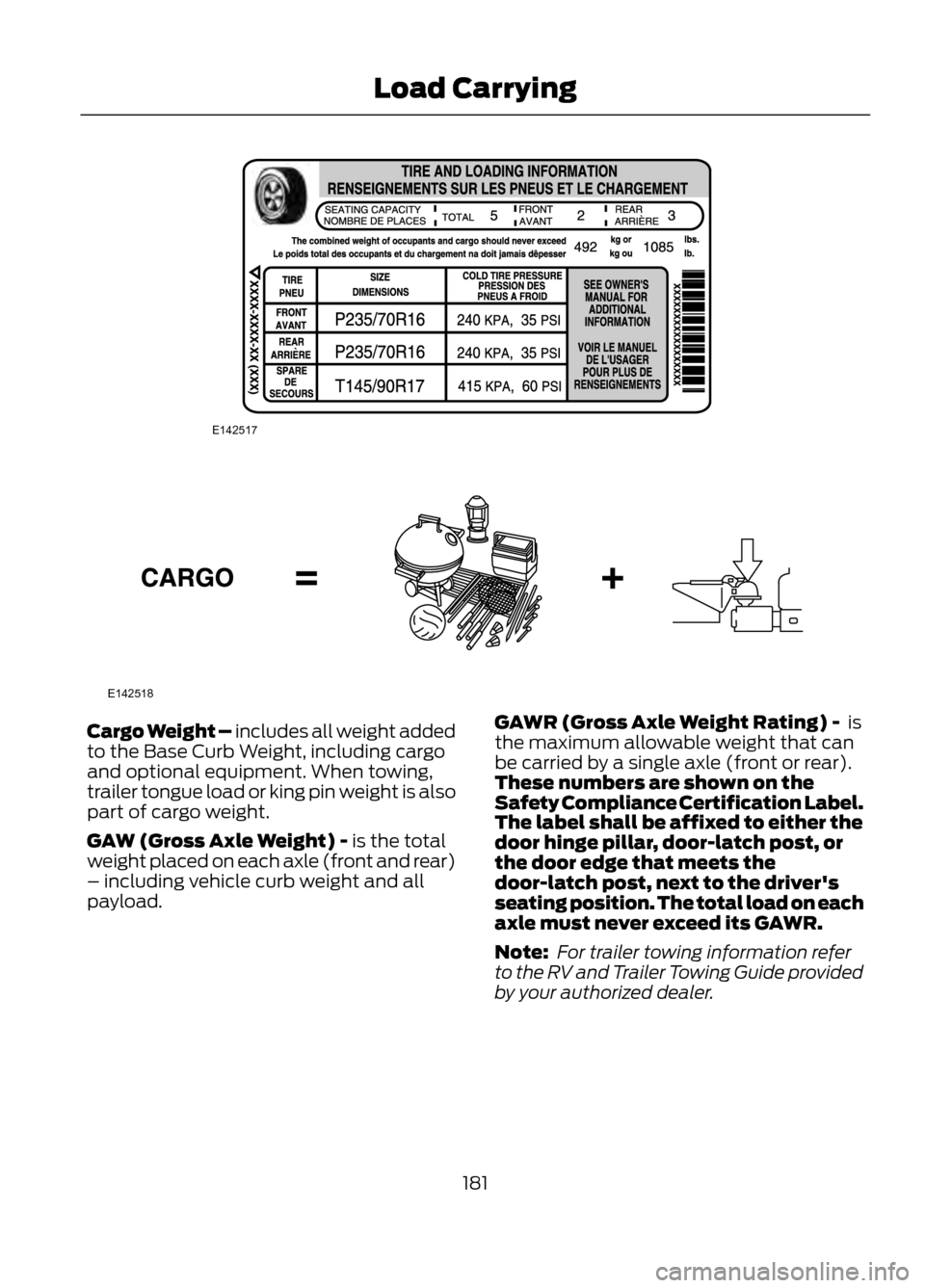
Cargo Weight – includes all weight added
to the Base Curb Weight, including cargo
and optional equipment. When towing,
trailer tongue load or king pin weight is also
part of cargo weight.
GAW (Gross Axle Weight) - is the total
weight placed on each axle (front and rear)
– including vehicle curb weight and all
payload.GAWR (Gross Axle Weight Rating) - is
the maximum allowable weight that can
be carried by a single axle (front or rear).
These numbers are shown on the
Safety Compliance Certification Label.
The label shall be affixed to either the
door hinge pillar, door-latch post, or
the door edge that meets the
door-latch post, next to the driver's
seating position. The total load on each
axle must never exceed its GAWR.
Note:
For trailer towing information refer
to the RV and Trailer Towing Guide provided
by your authorized dealer.
181
Load Carrying
E142517
E142518
Page 182 of 423
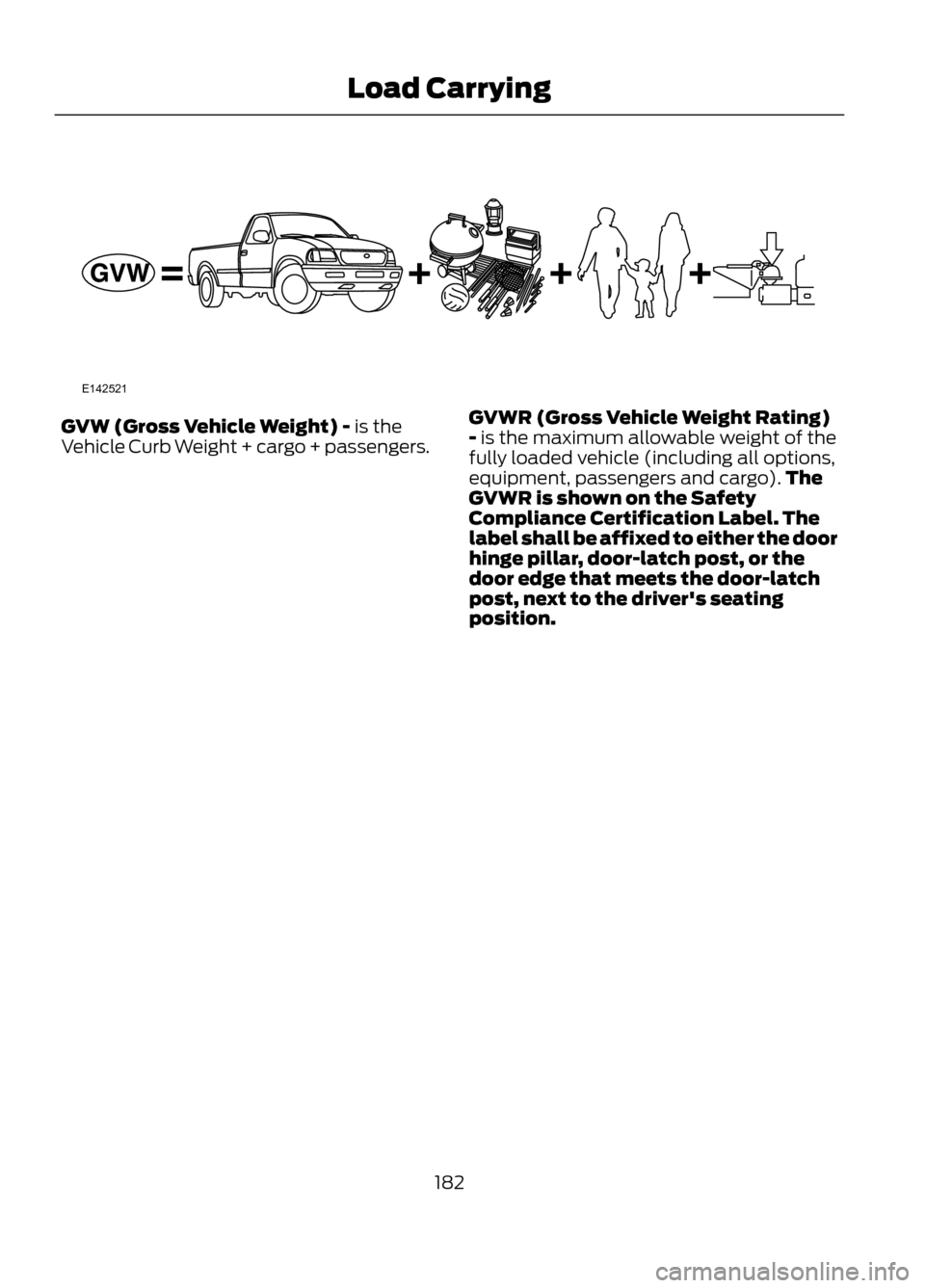
GVW (Gross Vehicle Weight) - is the
Vehicle Curb Weight + cargo + passengers.GVWR (Gross Vehicle Weight Rating)
- is the maximum allowable weight of the
fully loaded vehicle (including all options,
equipment, passengers and cargo).
The
GVWR is shown on the Safety
Compliance Certification Label. The
label shall be affixed to either the door
hinge pillar, door-latch post, or the
door edge that meets the door-latch
post, next to the driver's seating
position.
182
Load Carrying
E142521
Page 183 of 423
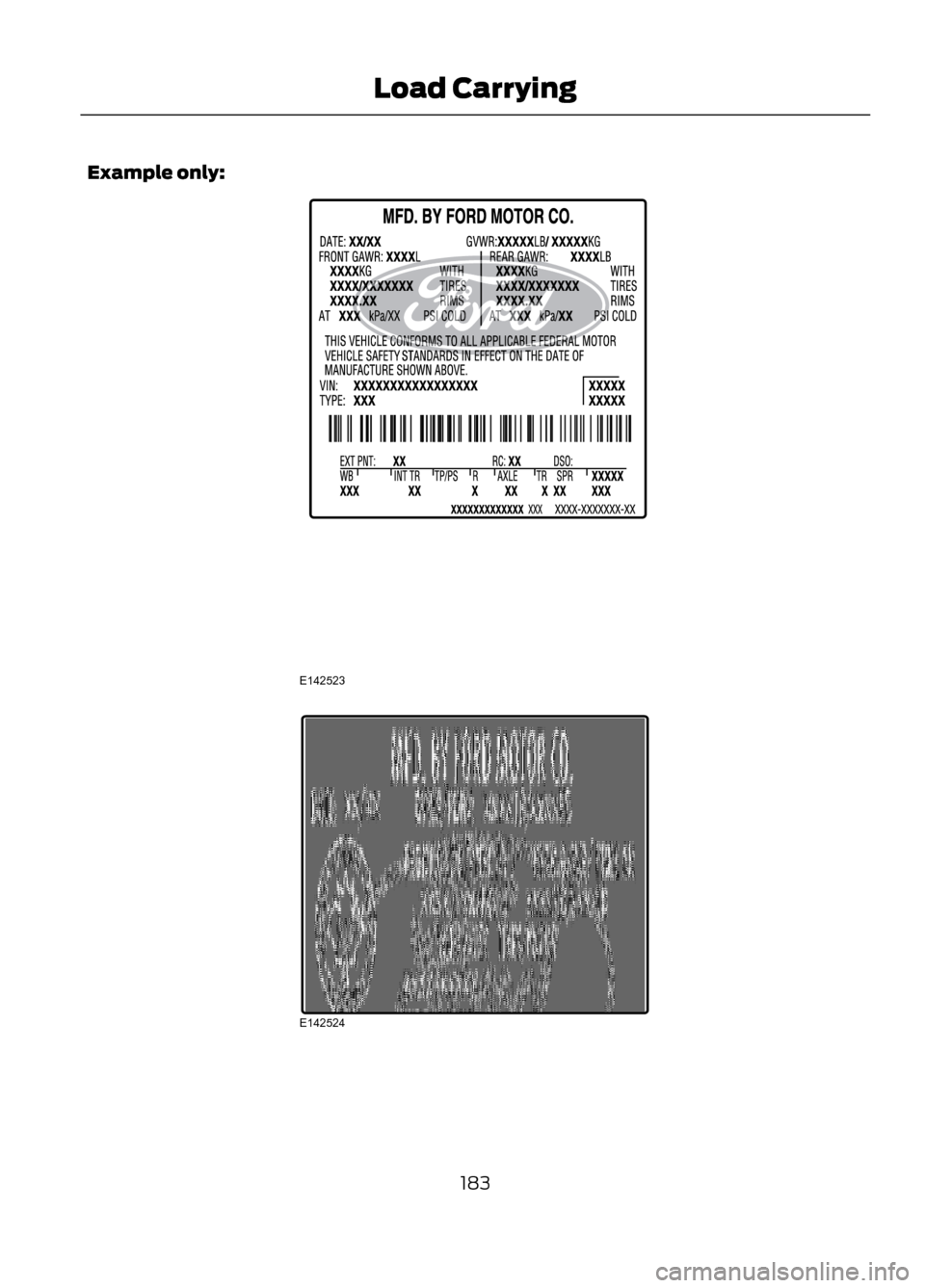
Example only:
183
Load Carrying
E142523
E142524
Page 184 of 423
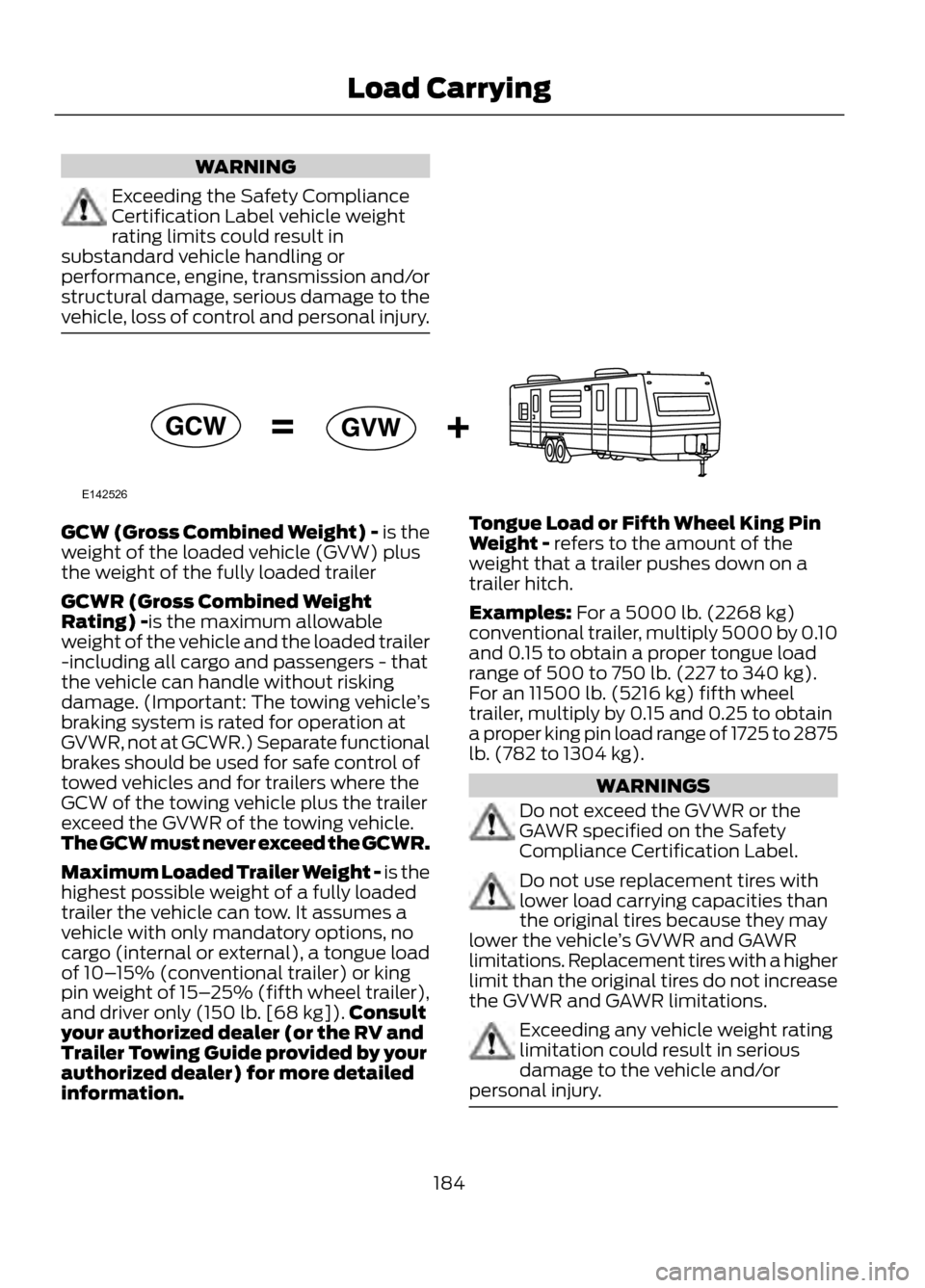
WARNING
Exceeding the Safety Compliance
Certification Label vehicle weight
rating limits could result in
substandard vehicle handling or
performance, engine, transmission and/or
structural damage, serious damage to the
vehicle, loss of control and personal injury.
GCW (Gross Combined Weight) - is the
weight of the loaded vehicle (GVW) plus
the weight of the fully loaded trailer
GCWR (Gross Combined Weight
Rating) -is the maximum allowable
weight of the vehicle and the loaded trailer
-including all cargo and passengers - that
the vehicle can handle without risking
damage. (Important: The towing vehicle ’s
braking system is rated for operation at
GVWR, not at GCWR.) Separate functional
brakes should be used for safe control of
towed vehicles and for trailers where the
GCW of the towing vehicle plus the trailer
exceed the GVWR of the towing vehicle.
The GCW must never exceed the GCWR.
Maximum Loaded Trailer Weight - is the
highest possible weight of a fully loaded
trailer the vehicle can tow. It assumes a
vehicle with only mandatory options, no
cargo (internal or external), a tongue load
of 10– 15% (conventional trailer) or king
pin weight of 15– 25% (fifth wheel trailer),
and driver only (150 lb. [68 kg]). Consult
your authorized dealer (or the RV and
Trailer Towing Guide provided by your
authorized dealer) for more detailed
information. Tongue Load or Fifth Wheel King Pin
Weight - refers to the amount of the
weight that a trailer pushes down on a
trailer hitch.
Examples: For a 5000 lb. (2268 kg)
conventional trailer, multiply 5000 by 0.10
and 0.15 to obtain a proper tongue load
range of 500 to 750 lb. (227 to 340 kg).
For an 11500 lb. (5216 kg) fifth wheel
trailer, multiply by 0.15 and 0.25 to obtain
a proper king pin load range of 1725 to 2875
lb. (782 to 1304 kg).
WARNINGS
Do not exceed the GVWR or the
GAWR specified on the Safety
Compliance Certification Label.
Do not use replacement tires with
lower load carrying capacities than
the original tires because they may
lower the vehicle ’s GVWR and GAWR
limitations. Replacement tires with a higher
limit than the original tires do not increase
the GVWR and GAWR limitations.
Exceeding any vehicle weight rating
limitation could result in serious
damage to the vehicle and/or
personal injury.
184
Load Carrying
E142526
Page 185 of 423

Steps for determining the correct load
limit:
1. Locate the statement "The combinedweight of occupants and cargo should
never exceed XXX kg or XXX lb." on
your vehicle ’s placard.
2. Determine the combined weight of the
driver and passengers that will be riding
in your vehicle.
3. Subtract the combined weight of the driver and passengers from XXX kg or
XXX lb.
4. The resulting figure equals the available amount of cargo and luggage
load capacity. For example, if the “XXX”
amount equals 1,400 lb. and there will
be five 150 lb. passengers in your
vehicle, the amount of available cargo
and luggage load capacity is 650 lb.
(1400-750 (5 x 150) = 650 lb.). In
metric units (635-340 (5 x 68) = 295
kg.)
5. Determine the combined weight of luggage and cargo being loaded on the
vehicle. That weight may not safely
exceed the available cargo and luggage
load capacity calculated in Step 4.
6. If your vehicle will be towing a trailer, load from your trailer will be transferred
to your vehicle. Consult this manual to
determine how this reduces the
available cargo and luggage load
capacity of your vehicle.
185
Load Carrying
Page 186 of 423

The following gives you a few examples
on how to calculate the available amount
of cargo and luggage load capacity:
•Another example for your vehicle with
1400 lb. (635 kg) of cargo and luggage
capacity. You decide to go golfing. Is
there enough load capacity to carry
you, 4 of your friends and all the golf
bags? You and four friends average
220 lb. (99 kg) each and the golf bags
weigh approximately 30 lb. (13.5 kg)
each. The calculation would be: 1400
- (5 x 220) - (5 x 30) = 1400 - 1100 -
150 = 150 lb. Yes, you have enough load
capacity in your vehicle to transport
four friends and your golf bags. In
metric units, the calculation would be:
635 kg - (5 x 99 kg) - (5 x 13.5 kg) =
635 - 495 - 67.5 = 72.5 kg. •
A final example for your vehicle with
1,400 lb. (635 kg) of cargo and luggage
capacity. You and one of your friends
decide to pick up cement from the local
home improvement store to finish that
patio you have been planning for the
past 2 years. Measuring the inside of
the vehicle with the rear seat folded
down, you have room for 12-100 lb. (45
kg) bags of cement. Do you have
enough load capacity to transport the
cement to your home? If you and your
friend each weigh 220 lb. (99 kg), the
calculation would be: 1400 - (2 x 220)
- (12 x 100) = 1400 - 440 - 1200 = - 240
lb. No, you do not have enough cargo
capacity to carry that much weight. In
metric units, the calculation would be:
635 kg - (2 x 99 kg) - (12 x 45 kg) = 635
- 198 - 540 = -103 kg. You will need to
reduce the load weight by at least 240
lb. (104 kg). If you remove 3-100 lb. (45
kg) cement bags, then the load
calculation would be:1400 - (2 x 220)
- (9 x 100) = 1400 - 440 - 900 = 60 lb.
Now you have the load capacity to
transport the cement and your friend
home. In metric units, the calculation
would be: 635 kg - (2 x 99 kg) - (9 x 45
kg) = 635 - 198 - 405 = 32 kg.
The above calculations also assume that
the loads are positioned in your vehicle in
a manner that does not overload the Front
or the Rear Gross Axle Weight Rating
specified for your vehicle on the Safety
Compliance Certification Label. The label
shall be affixed to either the door hinge
pillar, door-latch post, or the door edge
that meets the door-latch post, next to the
driver's seating position.
186
Load Carrying
Page 187 of 423
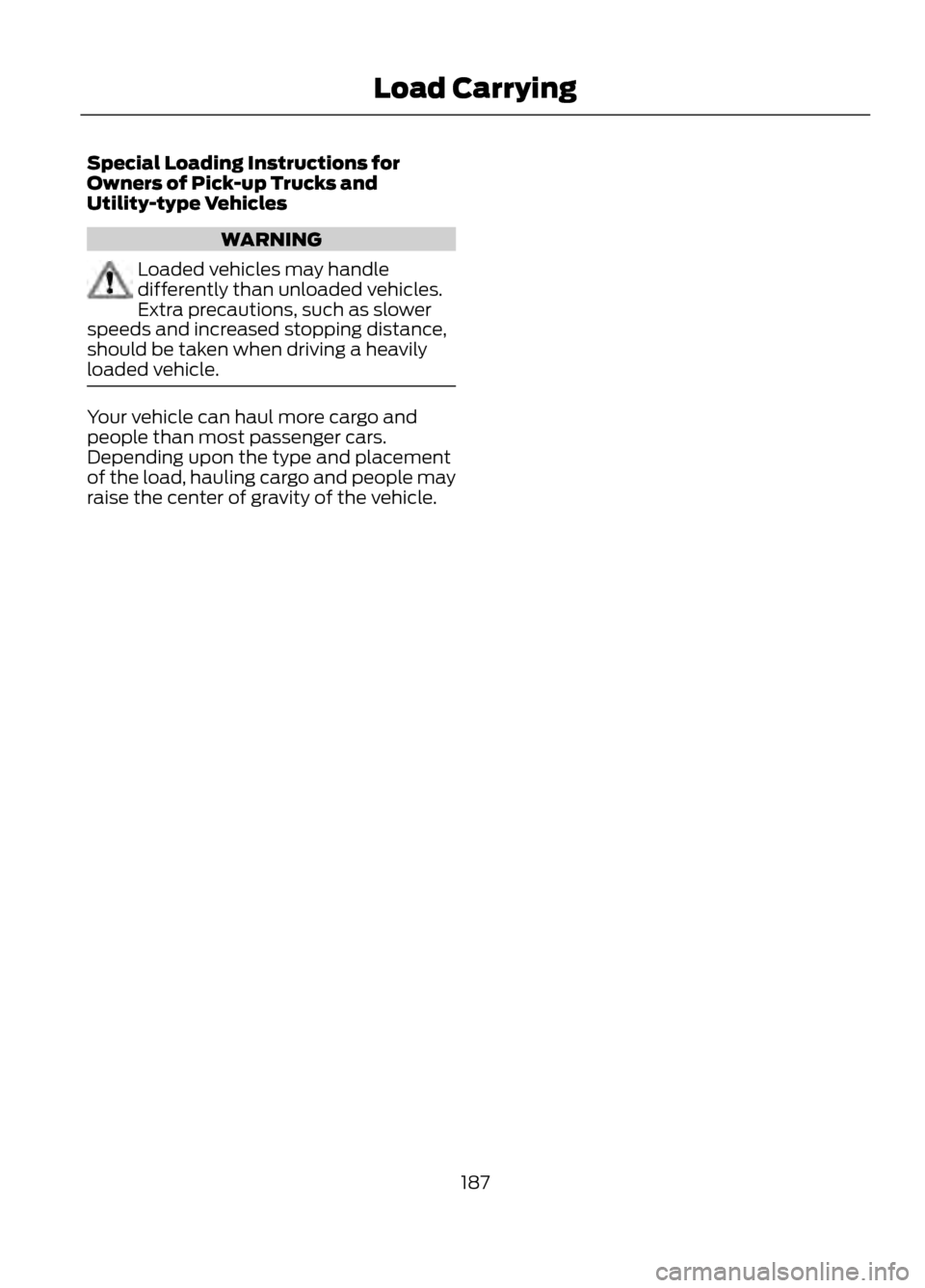
Special Loading Instructions for
Owners of Pick-up Trucks and
Utility-type Vehicles
WARNING
Loaded vehicles may handle
differently than unloaded vehicles.
Extra precautions, such as slower
speeds and increased stopping distance,
should be taken when driving a heavily
loaded vehicle.
Your vehicle can haul more cargo and
people than most passenger cars.
Depending upon the type and placement
of the load, hauling cargo and people may
raise the center of gravity of the vehicle.
187
Load Carrying
Page 188 of 423
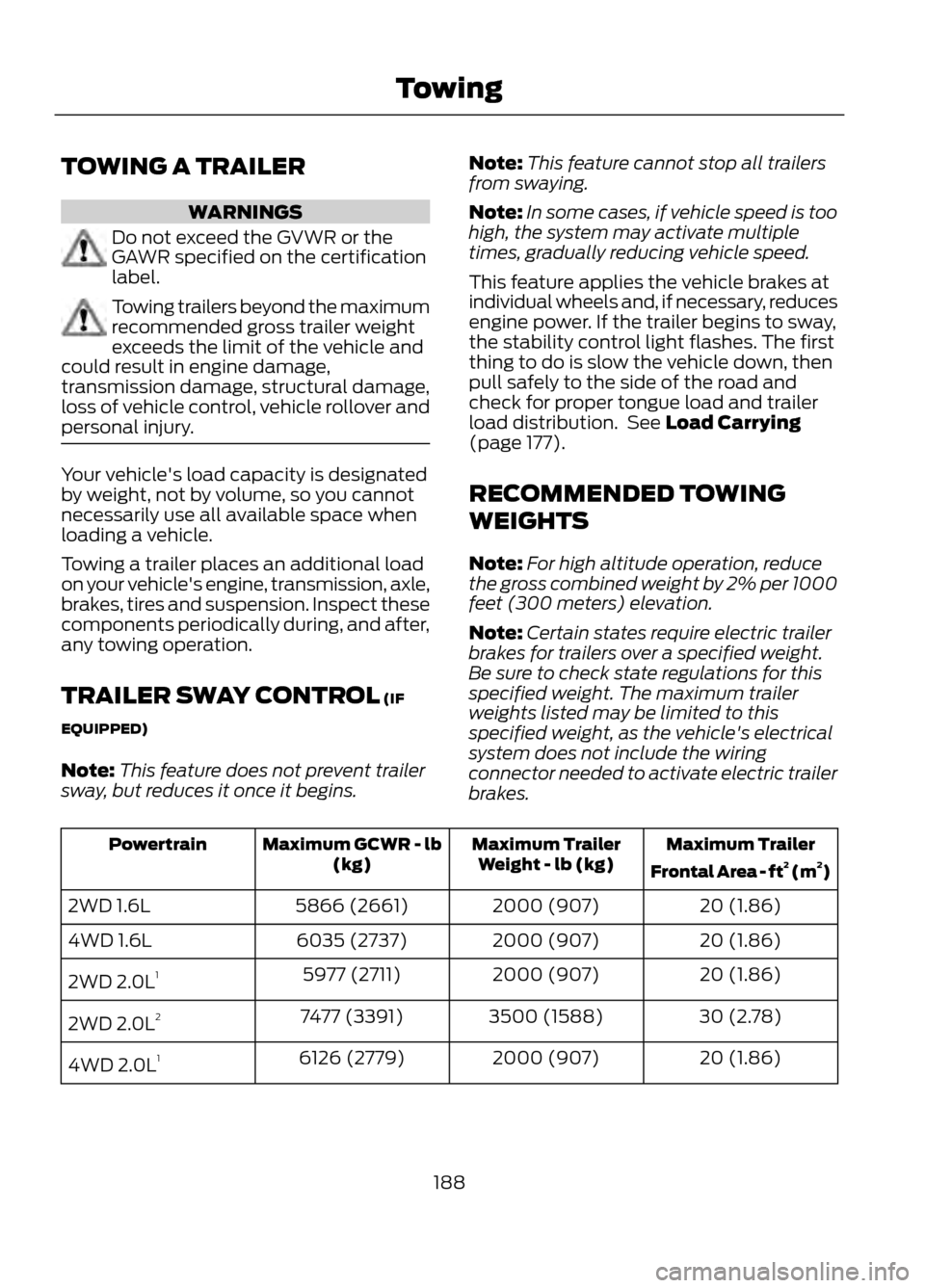
TOWING A TRAILER
WARNINGS
Do not exceed the GVWR or the
GAWR specified on the certification
label.
Towing trailers beyond the maximum
recommended gross trailer weight
exceeds the limit of the vehicle and
could result in engine damage,
transmission damage, structural damage,
loss of vehicle control, vehicle rollover and
personal injury.
Your vehicle's load capacity is designated
by weight, not by volume, so you cannot
necessarily use all available space when
loading a vehicle.
Towing a trailer places an additional load
on your vehicle's engine, transmission, axle,
brakes, tires and suspension. Inspect these
components periodically during, and after,
any towing operation.
TRAILER SWAY CONTROL (IF
EQUIPPED)
Note: This feature does not prevent trailer
sway, but reduces it once it begins. Note:
This feature cannot stop all trailers
from swaying.
Note: In some cases, if vehicle speed is too
high, the system may activate multiple
times, gradually reducing vehicle speed.
This feature applies the vehicle brakes at
individual wheels and, if necessary, reduces
engine power. If the trailer begins to sway,
the stability control light flashes. The first
thing to do is slow the vehicle down, then
pull safely to the side of the road and
check for proper tongue load and trailer
load distribution. See Load Carrying
(page 177).
RECOMMENDED TOWING
WEIGHTS
Note: For high altitude operation, reduce
the gross combined weight by 2% per 1000
feet (300 meters) elevation.
Note: Certain states require electric trailer
brakes for trailers over a specified weight.
Be sure to check state regulations for this
specified weight. The maximum trailer
weights listed may be limited to this
specified weight, as the vehicle's electrical
system does not include the wiring
connector needed to activate electric trailer
brakes.
Maximum Trailer
Frontal Area - ft 2
(m 2
)
Maximum Trailer
Weight - lb (kg)
Maximum GCWR - lb
(kg)
Powertrain
20 (1.86)
2000 (907)
5866 (2661)
2WD 1.6L
20 (1.86)
2000 (907)
6035 (2737)
4WD 1.6L
20 (1.86)
2000 (907)
5977 (2711)
2WD 2.0L 1
30 (2.78)
3500 (1588)
7477 (3391)
2WD 2.0L 2
20 (1.86)
2000 (907)
6126 (2779)
4WD 2.0L 1
188
Towing
Page 189 of 423
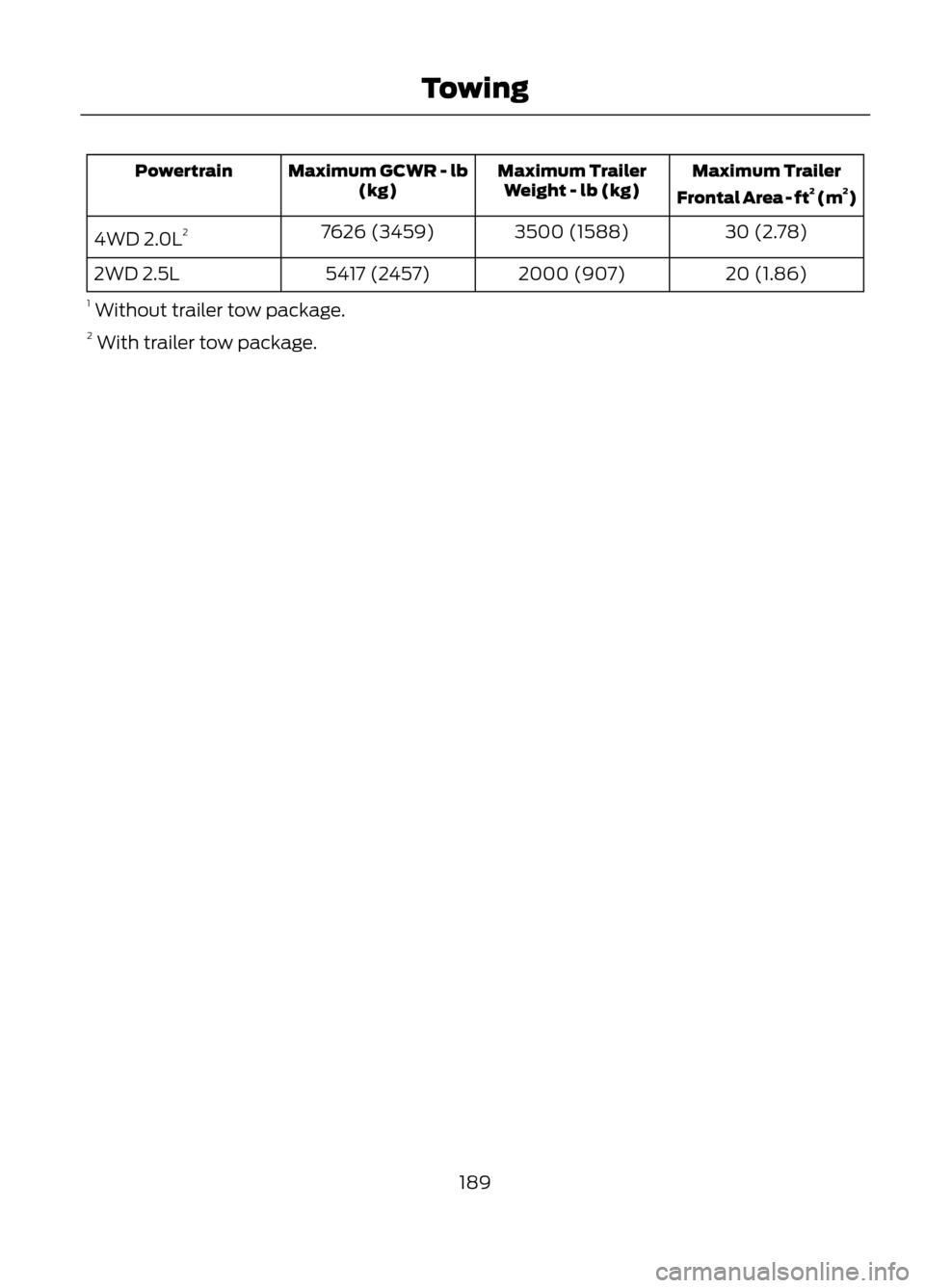
Maximum Trailer
Frontal Area - ft 2
(m 2
)
Maximum Trailer
Weight - lb (kg)
Maximum GCWR - lb
(kg)
Powertrain
30 (2.78)
3500 (1588)
7626 (3459)
4WD 2.0L 2
20 (1.86)
2000 (907)
5417 (2457)
2WD 2.5L
1 Without trailer tow package.
2 With trailer tow package.
189
Towing
Page 190 of 423
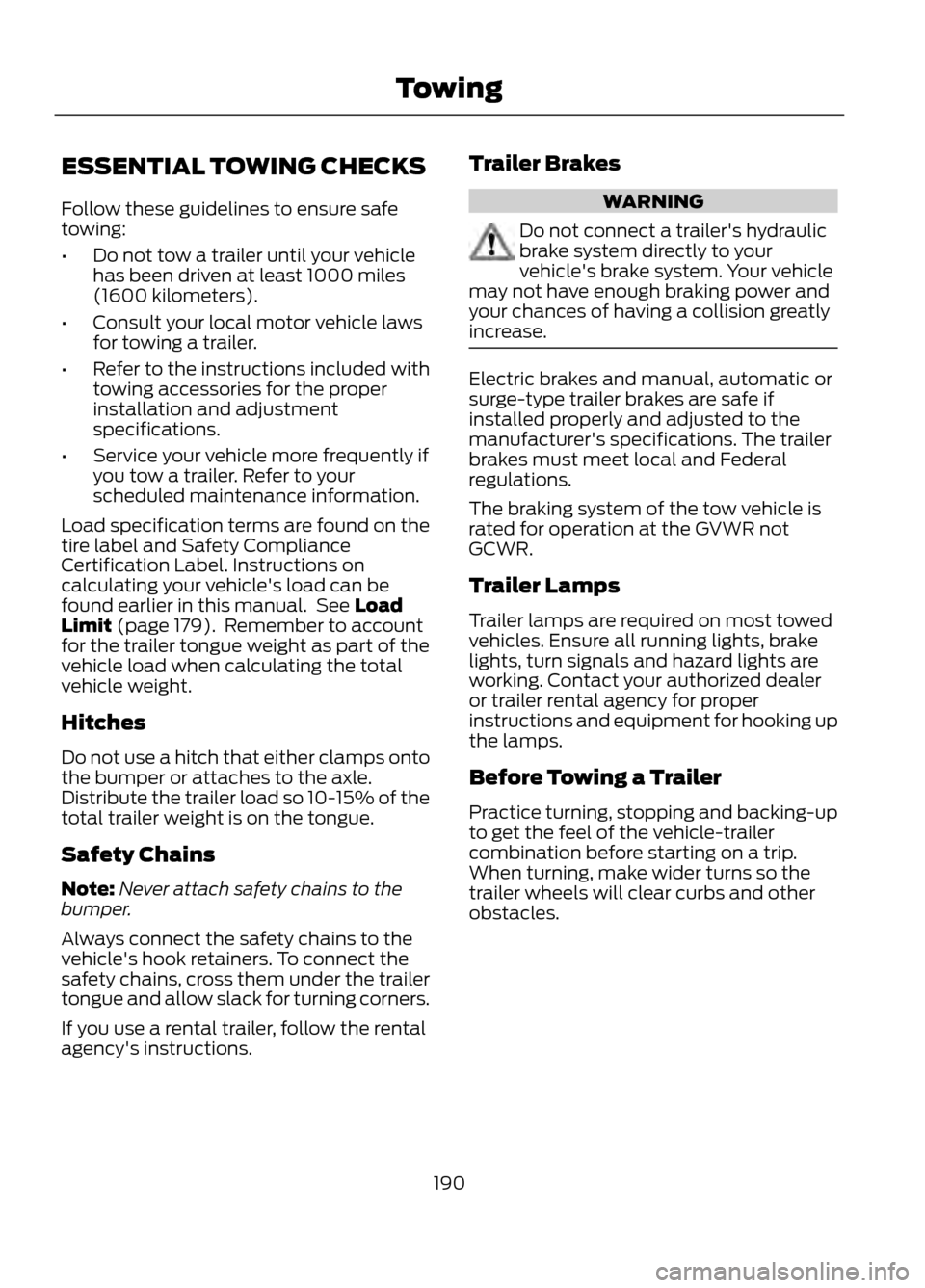
ESSENTIAL TOWING CHECKS
Follow these guidelines to ensure safe
towing:
•Do not tow a trailer until your vehicle
has been driven at least 1000 miles
(1600 kilometers).
• Consult your local motor vehicle laws
for towing a trailer.
• Refer to the instructions included with
towing accessories for the proper
installation and adjustment
specifications.
• Service your vehicle more frequently if
you tow a trailer. Refer to your
scheduled maintenance information.
Load specification terms are found on the
tire label and Safety Compliance
Certification Label. Instructions on
calculating your vehicle's load can be
found earlier in this manual. See Load
Limit (page 179). Remember to account
for the trailer tongue weight as part of the
vehicle load when calculating the total
vehicle weight.
Hitches
Do not use a hitch that either clamps onto
the bumper or attaches to the axle.
Distribute the trailer load so 10-15% of the
total trailer weight is on the tongue.
Safety Chains
Note: Never attach safety chains to the
bumper.
Always connect the safety chains to the
vehicle's hook retainers. To connect the
safety chains, cross them under the trailer
tongue and allow slack for turning corners.
If you use a rental trailer, follow the rental
agency's instructions. Trailer Brakes
WARNING
Do not connect a trailer's hydraulic
brake system directly to your
vehicle's brake system. Your vehicle
may not have enough braking power and
your chances of having a collision greatly
increase.
Electric brakes and manual, automatic or
surge-type trailer brakes are safe if
installed properly and adjusted to the
manufacturer's specifications. The trailer
brakes must meet local and Federal
regulations.
The braking system of the tow vehicle is
rated for operation at the GVWR not
GCWR.
Trailer Lamps
Trailer lamps are required on most towed
vehicles. Ensure all running lights, brake
lights, turn signals and hazard lights are
working. Contact your authorized dealer
or trailer rental agency for proper
instructions and equipment for hooking up
the lamps.
Before Towing a Trailer
Practice turning, stopping and backing-up
to get the feel of the vehicle-trailer
combination before starting on a trip.
When turning, make wider turns so the
trailer wheels will clear curbs and other
obstacles.
190
Towing